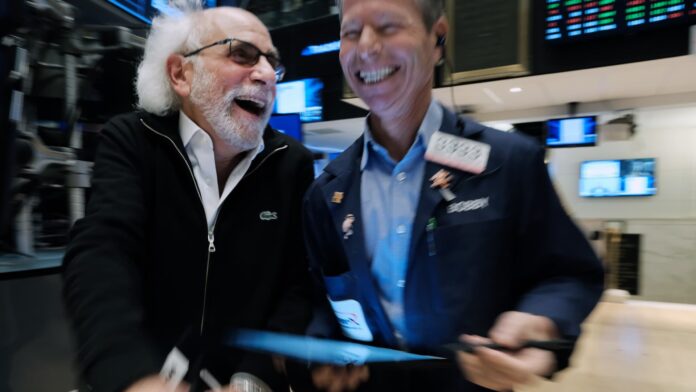October’s cooler-than-expected consumer inflation report triggered a massive surge in stocks that could herald the traditional midterm election year fourth-quarter rally. Bond yields fell hard, as stocks galloped higher after October’s consumer price index rose 0.4%, less than the 0.6% expected. The gain was 7.7% from a year ago, less than the 7.9% expected by economists surveyed by Dow Jones. Core inflation, excluding food and energy, also surprised, rising 0.3% month over month compared to estimates for a 0.5% gain. Strategists have been expecting a fourth-quarter rally, since in midterm election years, that historically has been the case. Now that Tuesday’s election is over, and inflation looks to be heading in the right direction, strategists say the time could be right for a risk rally. To be sure, they also caution that there’s risk the rally could be derailed by another hot inflation report or other factors, like the crypto meltdown. Thursday’s CPI report breaks a string of inflation surprising to the upside. As the Dow Jones Industrial Average jumped more than 800 points, the 10-year Treasury yield slumped to 3.82%. Yields move opposite price. The Nasdaq, most impacted by higher rates, rallied 5.6%. In the futures market, traders bet on a lower end point for the Federal Reserve’s rate hikes. Fed funds futures priced in a terminal rate for fed funds of 4.88% by May, down from 5.05% before the inflation report, according to BMO. “Midterms are over. We’ve finally broken the trend of inflation here,” said Jim Paulsen, chief investment strategist at Leuthold Group. “We put some doubt on what the Fed may or may not do. And who knows, Russia just had another big loss yesterday.” Russia’s invasion of Ukraine had been a big catalyst for inflation this year since it resulted in increases in the price of energy and other commodities. “We thought there had been multiple triggers for a rally building over several weeks,” said Julian Emanuel, head of equity, derivatives and quantitative strategy at Evercore ISI. Evercore ISI had called a peak in inflation previously, but the CPI report more clearly pointed to a decline that was embraced broadly in the market Thursday. Emanuel said that, given the extreme focus on inflation this year and the “extreme positive stock bond correlation and the correlation of the dollar to stocks,” the market moves Thursday were clearly important. “The fact that the CPI has triggered such a volatile decline in yields and a volatile decline in the dollar absolutely tells you the psychology of the stock market has changed consistent with a very positive yearend, post midterm seasonality,” Emanuel said. Emanuel said the market now sees inflation moderating, adding that there’s potential for the Fed to pause in 2023 though strategists expect the central bank to hold rates at higher levels. “Our year end price target is 3,975 [for the S & P 500]. If you only look at the degree of the bear market rally from the last low in June, and think about that we could get to 4,150,” he said. The S & P 500 was just above 3,900 in morning trading. Strategists also point to risks, including the meltdown in the crypto market with the collapse of crypto exchange FTX a nd big losses by crypto investors. Bitcoin also rallied after the CPI report, gaining more than 6% to a level of $17,554 on Coin Metrics in mid-morning trading. “While the jury is still out, it does seem as if the economy is going to be resilient enough such that crypto won’t be the contagion feared as much as it was 24 hours ago,” said Emanuel. What will the Fed do? The CPI report may have eased the view the Fed will continue to raise rates well above 5% for now. But the report is just one input for the Fed, which is expected to continue raising interest rates into next spring. “Now the question is what we hear from the Fed. That will determine how far the rally can extend. A single data point is not enough to make that assertion entirely but it add to that case [for peak inflation],” said Ben Jeffery, rate strategist at BMO. Economists had been expecting some easing in inflation, and it could continue to moderate as shelter and other costs come down in coming months. “This confirms the Fed’s own view they need more measured rate hikes now but this doesn’t stop them,” said KPMG chief economist Diane Swonk. ” It just affirms their plan.” She expects the Fed to keep hiking and then hold rates steady at higher levels to keep inflation in check. But she said inflation is going in the right direction. The prices of housing-related items, like appliances and furniture are falling, and she expects CPI will show a sharp decline in shelter costs early next year. “From the Fed’s perspective, this is welcome news but not enough to stop them from raising rates and tightening,” she said. “What I’m more concerned about is how rapidly you can compress the lags on this. We just don’t know what’s going on in crypto and where are the land mines that could trigger in terms of the larger credit market tightening.” Strategists warn the rally could be temporary, and Emanuel called it a “bear market rally.” Paulsen said soon the market’s focus could shift back to the idea the economy could fall into recession next year. “The problem is going to be very quickly that anxiety is going to run to ‘is inflation slowing, but then so is growth?'” said Paulsen. “I think the market will be okay with that but that’s definitely where it’s going to go. The other discussion that comes back into play, is can we soft land? That will be a powerful discussion if people think the war on inflation is being run but they also think it’s just a midyear slowdown.”
© heardonwallstreet.com


